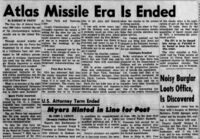1965-07-01-sc-p12-end-of-atlas-program
July 01, 1965 Spokane Daily Chronicle Page 12:
Atlas Missile Era Is Ended
By ROBERT W. PETTY
The first day of federal fiscal year 1966 today marked the end of the intercontinental ballistic missile era in the Inland Empire.
Through several months of quiet activity the Air Force has dispatched its 10 Atlas missiles to a California base and reassigned its 538 military personnel and 13 civilians. Inactivated last week was the 567th Strategic Missile Squadron to which the missile men were assigned.
Still remaining are the nine underground bulwarks of the $150 million installations and the central missile building at Fairchild Air Force Base.
What is to become of the eight massive underground fortresses in Eastern Washington and the one in Idaho near Rockford? Query Partly Answered
This question was in part answered by Col. D. J. Coonan, Fairchild base commander, the base engineering section and Spokane County.
The Air Force has announced that the nine missile sites are up for sale through the General Services Administration.
To date the sites have not been sold although the chairman of the Board of County Commissioners, Howard T. Ball, has requested possession of the sites at Deer Park and Newman Lake.
County Commissioner Jack V. Geraghty reported the county is asking for the sites for use as recreation areas and possibly would preserve intact a portion of one as a museum to show visitors the workings of the ICBM sites.
A second proposed use by the county is for storage of snow removal equipment. Also proposed is the use for county Civil Defense storage and for an underground communications center.
Price May be Cut
GSA has informed Ball that the county requested sites may be sold for half the appraised value if it is used for recreational purposes, The county has investigated the recreational possibilities and has included the missile site in its 10-year plan to get state and federal funds.
It was only seven years ago that the Spokane area learned it probably would get Atlas missiles assigned in this area. About 20 months later the first 85-foot- long Atlas missile was flown to Fairchild and tested to see if it was ready to be launched on a 9,000-mile arc to an enemy target if needed.
To house the missiles, contractors dug underground rooms 93x115 feet and 57x93 feet and connected them with steel-lined tunnels.
Still in prime condition are these nine underground structures at Deer Park, Newman Lake, Rockford, Sprague, Creston, Egypt, Lamona, Davenport and Reardan.
Each site has 9,200 tons of reinforced concrete and massive 800,000-pound rolling steel and concrete doors which opened to allow the missile to be erected to firing position.
Also linking the sites to Fairchild are 10 microwave installations that provide wireless telephone service.
Col. Coonan pointed out that these are being torn down and shipped to the National Aeronautics and Space Administration for use elsewhere.
Catalogs Readied
Bulky catalogs of items up for sale at the sites have been prepared for the Department of Defense and are available for any of the prospective purchasers of missile site equipment.
Col. Coonan said that of the missile squadron personnel, 220 have been transferred to other jobs on the base and the remainder have been transferred to duty elsewhere.
One of the interesting sidelights of the orderly dismantling of the missile sites is the application of part of the fuel for the Atlas. To make them fly the missile men had on hand large quantities of liquid oxygen and of RP1, a kerosene-like petroleum product.
The RP1 is to be dumped into storage at Fairchild to be burned to heat the base this winter.
The Atlas missiles at Fairchild (and the Titan missiles at Larson Air Force Base) were rendered obsolete by Minutemen solid propellant missiles. The closest of these are in Montana.
